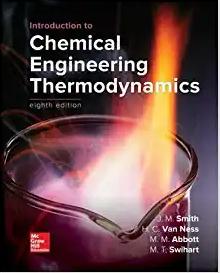

Saponification of ethyl acetate to produce sodium acetate and ethanol is a well-known and wellcharacterized reaction. Its kinetics are known to be overall second order, with the following elementary reaction: CH3COOC2H5+NaOHCH3COONa+C2H5OH The following data was collected using conductivity measurements by Das and colleagues (Das, et al, International Journal of Chemical Kinetics, 2011). The data were collected using a differential batch reaction with a constant temperature water bath and continuous stirring. Your goal is to use this data to design a continuous process that produces 100mol/s ethanol. Your feed stream is at 298K. The inlet molar flow rate is 500mol/s and is equimolar in ethyl acetate and sodium hydroxide. The feed stream is 50% water (by mole fraction). The volumetric flow rate is 100dm3/s. Note: all of the information you need to solve this problem may not be given in the problem statement. a) Calculate the minimum PFR volume needed for this design specification assuming isothermal operation at 298K. b) What will your reactor volume be if the reactor is adiabatic and the inlet feed temperature is 298K ? c) What will your reactor volume if you design one with co-current heat exchange, Ua= 10000W/(m3K) and constant Ta=298K Saponification of ethyl acetate to produce sodium acetate and ethanol is a well-known and wellcharacterized reaction. Its kinetics are known to be overall second order, with the following elementary reaction: CH3COOC2H5+NaOHCH3COONa+C2H5OH The following data was collected using conductivity measurements by Das and colleagues (Das, et al, International Journal of Chemical Kinetics, 2011). The data were collected using a differential batch reaction with a constant temperature water bath and continuous stirring. Your goal is to use this data to design a continuous process that produces 100mol/s ethanol. Your feed stream is at 298K. The inlet molar flow rate is 500mol/s and is equimolar in ethyl acetate and sodium hydroxide. The feed stream is 50% water (by mole fraction). The volumetric flow rate is 100dm3/s. Note: all of the information you need to solve this problem may not be given in the problem statement. a) Calculate the minimum PFR volume needed for this design specification assuming isothermal operation at 298K. b) What will your reactor volume be if the reactor is adiabatic and the inlet feed temperature is 298K ? c) What will your reactor volume if you design one with co-current heat exchange, Ua= 10000W/(m3K) and constant Ta=298K








